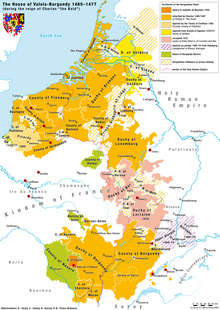
The Burgundian inheritance in the Low Countries consisted of numerous fiefs held by the Dukes of Burgundy in modern-day Belgium, Netherlands, Luxembourg, and in parts of France and Germany. The duke of Burgundy was originally a member of the House of Valois-Burgundy and later of the House of Habsburg. Given that the dukes of Burgundy lost Burgundy proper to the Kingdom of France in 1477, and were never able to recover it, while retaining Charolais and the Free County of Burgundy, they moved their court to the Low Countries. The Burgundian Low Countries were ultimately expanded to include Seventeen Provinces under Emperor Charles V. The Burgundian inheritance then passed to the Spanish branch of the Habsburgs under King Philip II of Spain, whose rule was contested by the Dutch revolt, and fragmented into the Spanish Netherlands and the Dutch republic. Following the War of the Spanish succession, the Spanish Netherlands passed to Austria and remained in Austrian hands until the French conquest of the late 18th century. The Bourbon Restoration did not re-establish the Burgundian states, with the former Burgundian territories remaining divided between France, the Netherlands and, following the Belgian Revolution, modern-day Belgium.